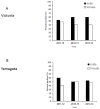Epidemiological and Virological Characterization of Influenza B Virus Infections
- PMID: 27533045
- PMCID: PMC4988634
- DOI: 10.1371/journal.pone.0161195
Epidemiological and Virological Characterization of Influenza B Virus Infections
Abstract
While influenza A viruses comprise a heterogeneous group of clinically relevant influenza viruses, influenza B viruses form a more homogeneous cluster, divided mainly into two lineages: Victoria and Yamagata. This divergence has complicated seasonal influenza vaccine design, which traditionally contained two seasonal influenza A virus strains and one influenza B virus strain. We examined the distribution of the two influenza B virus lineages in Israel, between 2011-2014, in hospitalized and in non-hospitalized (community) influenza B virus-infected patients. We showed that influenza B virus infections can lead to hospitalization and demonstrated that during some winter seasons, both influenza B virus lineages circulated simultaneously in Israel. We further show that the influenza B virus Yamagata lineage was dominant, circulating in the county in the last few years of the study period, consistent with the anti-Yamagata influenza B virus antibodies detected in the serum samples of affected individuals residing in Israel in the year 2014. Interestingly, we found that elderly people were particularly vulnerable to Yamagata lineage influenza B virus infections.
Conflict of interest statement
Figures







Similar articles
-
Exceptional influenza morbidity in summer season of 2017 in Israel may predict the vaccine efficiency in the coming winter.Vaccine. 2018 Mar 7;36(11):1326-1329. doi: 10.1016/j.vaccine.2018.01.085. Vaccine. 2018. PMID: 29429813
-
A comparison of the demographic and clinical characteristics of laboratory-confirmed influenza B Yamagata and Victoria lineage infection.J Clin Virol. 2014 Sep;61(1):156-60. doi: 10.1016/j.jcv.2014.06.018. Epub 2014 Jun 27. J Clin Virol. 2014. PMID: 25034374
-
Co-circulation of the two influenza B lineages during 13 consecutive influenza surveillance seasons in Italy, 2004-2017.BMC Infect Dis. 2019 Nov 21;19(1):990. doi: 10.1186/s12879-019-4621-z. BMC Infect Dis. 2019. PMID: 31752738 Free PMC article.
-
[Molecular characterization of human influenza viruses--a look back on the last 10 years].Berl Munch Tierarztl Wochenschr. 2006 Mar-Apr;119(3-4):167-78. Berl Munch Tierarztl Wochenschr. 2006. PMID: 16573207 Review. German.
-
Quadrivalent Ann Arbor strain live-attenuated influenza vaccine.Expert Rev Vaccines. 2012 Nov;11(11):1293-303. doi: 10.1586/erv.12.108. Epub 2012 Nov 14. Expert Rev Vaccines. 2012. PMID: 23151111 Review.
Cited by
-
Age-Related Differences in Influenza B Infection by Lineage in a Community-Based Sentinel System, 2010-2011 to 2015-2016, Canada.J Infect Dis. 2017 Sep 15;216(6):697-702. doi: 10.1093/infdis/jix393. J Infect Dis. 2017. PMID: 28934439 Free PMC article.
-
Development and Effects of Influenza Antiviral Drugs.Molecules. 2021 Feb 4;26(4):810. doi: 10.3390/molecules26040810. Molecules. 2021. PMID: 33557246 Free PMC article. Review.
-
The Israel National Sera Bank: Methods, Representativeness, and Challenges.Int J Environ Res Public Health. 2021 Feb 25;18(5):2280. doi: 10.3390/ijerph18052280. Int J Environ Res Public Health. 2021. PMID: 33668988 Free PMC article.
-
Drug update - Baloxavir marboxil: Latest entrant into the arena of pharmacotherapy of influenza.Med J Armed Forces India. 2022 Apr;78(2):125-130. doi: 10.1016/j.mjafi.2021.09.005. Epub 2021 Nov 24. Med J Armed Forces India. 2022. PMID: 35463549 Free PMC article. Review.
-
The Influenza B Virus Victoria and Yamagata Lineages Display Distinct Cell Tropism and Infection-Induced Host Gene Expression in Human Nasal Epithelial Cell Cultures.Viruses. 2023 Sep 20;15(9):1956. doi: 10.3390/v15091956. Viruses. 2023. PMID: 37766362 Free PMC article.
References
-
- Wright PNG, Kawaoka Y (2006) Orthomyxoviruses In Fields Virology 5th edition: 1691–1740.
-
- Osterhaus AD, Rimmelzwaan GF, Martina BE, Bestebroer TM, Fouchier RA (2000) Influenza B virus in seals. Science 288: 1051–1053. - PubMed
MeSH terms
Substances
LinkOut - more resources
Full Text Sources
Other Literature Sources
Medical

